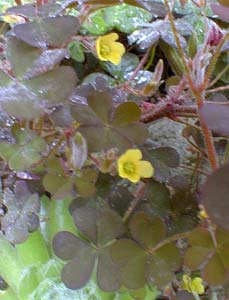
Purple Creeping Wood Sorrel,
or, Purple-leafed Procumbent Yellow Sorrel;
or, Creeping Oxalis;
or, Creeping Purple Lady's Sorrel
"White with daisies & red with sorrel
And empty, empty under the sky!
Life is a quest & love a quarrel
Here is a place for me to lie."
-from "Weeds"
by Edna St. Vincent Millay
(1892-1950)
by Edna St. Vincent Millay
(1892-1950)
Since this wild oxalis is impossible to ever be rid of, it might as well be enjoyed. It is awfully pretty after all. Though I pull it out occasionally, I just don't worry about it the way some people do; it & a few other weeds such as the dove's-foot crane's-bills are at some level a welcome component of our gardens.
Oxalis corniculata variant atropurpurea is of European origin, though from which part it first began to spread throughout the continent is unknown, it began its conquest so long ago. It has migrated alongside humanity throughout the world, the small seeds harbored in all our harvested grains & livestock feeds. It is fully established around the globe, especially in cool & temperate regions. It has purple leaves & yellow flowers. The leaves of the purple variant are usually flat, whereas the leaves of other forms of O. corniculata are usually reflexed.
Although it is largely an annual, it self-seeds in-place so inescapably that it has the effect of a perennial recurring in the same locations year after year. It does seem to me it is at least partially a perennial, because at the center of its creeping spread it has a taproot that if not meddled with appears to me to produce a much larger creeper-clump year by year, sendsing runners over the surface of the ground like some miniature strawberry vine, rooting itself in stages. In less ideal places it seems always to be starting over from seed. It easily erupts in new locations, since it can "explode" its seeds a considerable distance.
It flowers May through most of summer. It likes moist partially shady spots & looks its best in such locations, but I've seen it in surprisingly dry spots where it rushes through its lifecycle & seeds quickly. In moist shade it doesn't wear out as quicky, but a hot dry day will ruin its appearance very rapidly. Whenever some bit of it looks terrible, I feel no qualms about ripping it out, since it's a weed anyway.
The purple variant has somehow become more common than the regular green form, perhaps because gardeners have a tendency as I do to permit it more liberties due to its beauty. The only time it is seriously a burden is when it invades seedling greenhouses, or competes with seedlings right in the garden. It otherwise does not push out established plants; it merely has the knack of surviving in the knooks & corners between things.
Although generally creeping close to the ground four or six inches tall, it will also climb vine-like into shrubbery. It can rise to a foot or two feet through branches of little shrubs, particularly when it finds itself in considerable shade & seeks upward for a bit more sun.